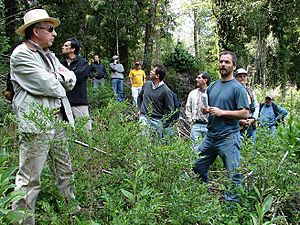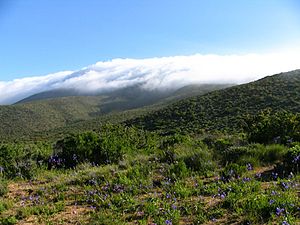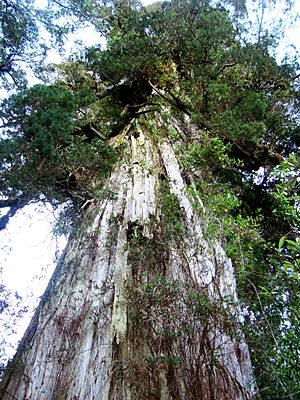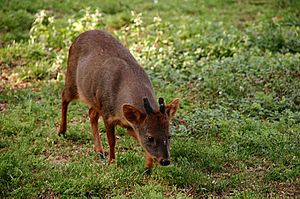Valdivian temperate forests facts for kids
Quick facts for kids Valdivian temperate forests (NT0404) |
|
|---|---|

Trees and understory at Oncol Park
|
|

Location in the south of South America
|
|
| Ecology | |
| Realm | Neotropical |
| Biome | Temperate broadleaf and mixed forests |
| Borders | Chilean matorral, Magellanic subpolar forests, Patagonian steppe and Southern Andean steppe |
| Geography | |
| Area | 248,100 km2 (95,800 sq mi) |
| Countries | Chile and Argentina |
| Conservation | |
| Protected | 24.16% |
The Valdivian temperate forests (NT0404) are a special type of ecoregion. They are found on the west coast of southern South America, mainly in Chile and Argentina. These forests are part of the Neotropical realm. They get their name from the city of Valdivia.
These forests have thick undergrowth made of bamboos and ferns. Most trees are evergreen angiosperms, meaning they keep their leaves all year. Some deciduous trees, which lose their leaves, are also found. Conifer trees, like pines, are also common here.
Contents
Where are the Valdivian Forests?
These temperate rainforests are in a narrow strip along the Chilean coast. They stretch between the Pacific Ocean to the west and the southern Andes Mountains to the east. This area is roughly from 37° to 48° south latitude.
North of 42° latitude, the Chilean Coast Range runs parallel to the Andes. The Chilean Central Valley is between these two mountain ranges. South of 42°, the coast range becomes a chain of islands. These include Chiloé Island and the Chonos Archipelago. The "Central Valley" here is underwater, forming the Gulf of Corcovado.
Long ago, much of this ecoregion was covered by the Patagonian Ice Sheet. This happened during the last ice age. Many lakes in the Chilean Lake District are left over from ancient glacial valleys. The southern part of the region has many fjords, which are deep, narrow inlets carved by glaciers.

To the north, the Valdivian forests change into the Mediterranean forests, woodlands, and scrub of the Chilean Matorral ecoregion. Some small areas of Valdivian forest still exist in north-central Chile. One example is Bosque de Fray Jorge National Park. These are remnants from the last glacial maximum. To the south, you find the Magellanic subpolar forests ecoregion.
The Valdivian, matorral, and Magellanic ecoregions are separated from other forests in South America. They are cut off by the Atacama desert, the Andes Mountains, and the dry Patagonian steppe. Because of this isolation, many species here are endemic. This means they are found nowhere else in the world.
What is the Climate Like?
The Valdivian forests are around 40 degrees south latitude. This means they are strongly affected by the westerlies, which are strong winds. These winds carry a lot of moisture from the Pacific Ocean. When the moist air hits the windward slopes of the Chilean Coast Range and the Andes, it cools. This causes a lot of orographic rainfall.
The amount of rain changes across the region. It can be 1,000 mm (about 39 inches) per year in the north. In the south, it can be more than 6,000 mm (about 236 inches) per year! The northern part has a Submediterranean climate. This means most rain falls in winter. This difference in seasons becomes less noticeable as you go south.
Temperatures are quite steady, especially near the coast. The ocean's Humboldt Current makes the coast humid and foggy. In summer, temperatures can reach 16.5 °C (62 °F). In winter, they can drop below 7 °C (45 °F). Higher places have colder winters. The tree line, where trees stop growing, is about 2,400 m (7,900 ft) high in the north. It goes down to 1,000 m (3,300 ft) in the south.
Plants of the Valdivian Forests
The Valdivian temperate rainforests are a type of temperate broadleaf and mixed forests. They are the only temperate rainforests in South America. They are also one of only a few in the world. Together with the Magellanic forests, they are the second largest temperate rainforests globally. The largest are the Pacific temperate rain forests in North America.
The Valdivian forests are a safe place for Antarctic flora. This means they share many plant families with temperate rainforests in New Zealand, Tasmania, and Australia. Half of all woody plant species here are endemic. They are found only in this ecoregion.
Chusquea quila is a type of bamboo. It grows in wet areas below 500 m (1,600 ft). Above this height, Chusquea culeou is more common. Chusquea quila can form dense stands called quilantales. Very few other plants can grow under them. Other important plants include the nalca or Chilean rhubarb (Gunnera tinctoria). There are also ferns like Lophosoria quadripinnata and Parablechnum cordatum. Chile's national flower, the copihue (Lapageria rosea), is a pioneer species. It grows in areas of the Valdivian rainforest that have been disturbed.
The greatest variety of plant species is found between 40° and 43° South latitude.
Types of Forest Ecosystems
There are four main types of forest ecosystems in the Valdivian ecoregion.
Deciduous Forests. These forests are at the northern end of the ecoregion. They are mostly made up of deciduous southern beech trees. Examples include rauli (Nothofagus alpina) and roble (N. obliqua). This area is a transition zone to the Mediterranean climate further north. It grows along the Chilean Coast Range from 35° to 36° S latitude. Here, it is called Maulino forest. Nothofagus glauca and N. Alessandrii are common trees in Maulino forest.
Deciduous Nothofagus forests also grow along the Andes of central Chile. They go as far north as 33° S latitude. They grow from about 1,200 meters (3,900 ft) up to the tree line at 2,400 meters (7,900 ft). A krummholz (stunted, wind-swept trees) of Nothofagus antarctica and N. pumilio grows near the tree line. The southern edge of these forests is at 38° S latitude. Tall coniferous pehuén monkey-puzzle trees (Araucaria araucana) grow at the southern edge of the deciduous forests. They are found from the coast at Nahuelbuta National Park to the Andes.
Valdivian Laurel-leaved Forests. These forests have many different broadleaf evergreen trees. Some examples are Laureliopsis philippiana, Aextoxicon punctatum, Eucryphia cordifolia, Caldcluvia paniculata, and Weinmannia trichosperma. The understory has plants like Myrceugenia planipes and the arrayán (Luma apiculata). Old-growth Valdivian evergreen forests often have two or three layers in their canopy.
Patagonian Andean Forests. This third type of forest is found at higher elevations along the Andes mountains. They are mostly made up of evergreen conifers. These include pehuén (Araucaria araucana) and alerce (Fitzroya cupressoides). The alerce tree looks like a giant sequoia. It can live for a very long time, some for over 3,625 years. Closer to the tree line, the conifers give way to Andean scrublands. These are made of deciduous Nothofagus antarctica trees.
Northern Patagonian Forests. This is the fourth type of forest. It covers the southern half of the ecoregion. It has evergreen species like the broadleaf Nothofagus dombeyi, Nothofagus betuloides, and Drimys winteri. It also has coniferous podocarps, including Podocarpus nubigenus.
Animals of the Valdivian Forests
The Valdivian forests are home to several threatened mammals. These include the monito del monte (Dromiciops gliroides). This is a small marsupial that lives in trees. There is also the southern pudú (Pudu puda). It is the world's smallest deer. The kodkod (Leopardus guigna) is South America's smallest cat. Since the early 1900s, non-native wild boars have also lived in these forests. The Chilean climbing mouse (Irenomys tarsalis) and Chilean shrew opossum (Rhyncholestes raphanurus) are found only in this ecoregion.
Most mammal types in Valdivian forests are also found in the semi-arid parts of Patagonia. Compared to similar forests in North America, Chilean temperate forests have fewer types of mammals.
The slender-billed parakeet (Enicognathus leptorhynchus) is found only here. Other birds found mostly or only here include the Chilean pigeon (Patagioenas araucana). Also, the Black-throated huet-huet (Pteroptochos tarnii), Chucao tapaculo (Scelorchilus rubecula), and Ochre-flanked tapaculo (Eugralla paradoxa). Hummingbirds are common in the Valdivian forests. This is because of plants like the maqui (Aristotelia chilensis) and the copihue.
Protecting the Valdivian Forests

The Valdivian forests have huge trees, especially Nothofagus and Fitzroya. These trees can live for a very long time. These amazing rainforests are in danger. They are being cut down for logging. Then, fast-growing pines and eucalyptus trees are planted in their place. These trees are used by the pulp and paper industry. The native trees that are cut down are often sent to Japan as woodchips.
People are working to protect these forests. In November 2003, a group of conservation organizations bought 147,500 acres (600 km2) of rainforest. This was in the Valdivian Coastal Range. It was a big step for conservation. Gianni Lopez, from Chile's environmental agency, said that protected areas not owned by the government were once "unthinkable." Ecotourism is also helping to protect these forests.
Protected Areas
About 24.16% of the Valdivian temperate forests ecoregion is now in protected areas.
List of Protected Areas
Argentina
- Los Alerces National Park
- Los Arrayanes National Park
- Lago Puelo National Park
- Lanín National Park
- Nahuel Huapí National Park
Chile
- Public Parks and Reserves:
- Alerce Andino National Park
- Alerce Costero National Park
- Altos de Lircay National Reserve
- Altos de Pemehue National Reserve
- Bosque de Fray Jorge National Park
- Carlos Anwandter Sanctuary
- Chiloé National Park
- China Muerta National Reserve
- Conguillío National Park
- Corcovado National Park
- Coyhaique National Reserve
- Futaleufú National Reserve
- Hornopirén National Park
- Huerquehue National Park
- Isla Guamblin National Park
- La Campana National Park
- Lago Rosselot National Reserve
- Laguna del Laja National Park
- Laguna San Rafael National Park
- Lahuen Ñadi Natural Monument
- Llanquihue National Reserve
- Los Bellotos del Melado National Reserve
- Los Huemules de Niblinto National Reserve
- Los Queules National Reserve
- Los Ruiles National Reserve
- Melimoyu National Park
- Mocho-Choshuenco National Reserve
- Nahuelbuta National Park
- Nonguén National Park
- Península de Hualpén Nature Sanctuary
- Pumalín Douglas Tompkins National Park
- Puyehue National Park
- Queulat National Park
- Radal Siete Tazas National Park
- Ralco National Reserve
- Río Los Cipreses National Reserve
- Tolhuaca National Park
- Vicente Perez Rosales National Park
- Villarrica National Park
- Private Reserves:
- Huilo-Huilo Biological Reserve (owned by Víctor Peterman)
- Llancahue (managed by the Austral University of Chile)
- Los Vertientes Private Nature Reserve
- Meullín-Puye Nature Sanctuary (managed by the Kreen Foundation)
- Oncol Park (owned by Celulosa Arauco y Constitución)
- Área Costera Protegida Punta Curiñanco (owned by CODEFF)
- Tantauco Park (owned by Sebastián Piñera)
- Valdivian Coastal Reserve (owned by The Nature Conservancy)
Images for kids
-
Nalca plants at Cuesta Queulat in Queulat National Park.
See also
 In Spanish: Ecorregión bosque valdiviano para niños
In Spanish: Ecorregión bosque valdiviano para niños
- Chilean Native Forest Law
- Chilean matorral
- Magellanic subpolar forests
- Maulino forest





